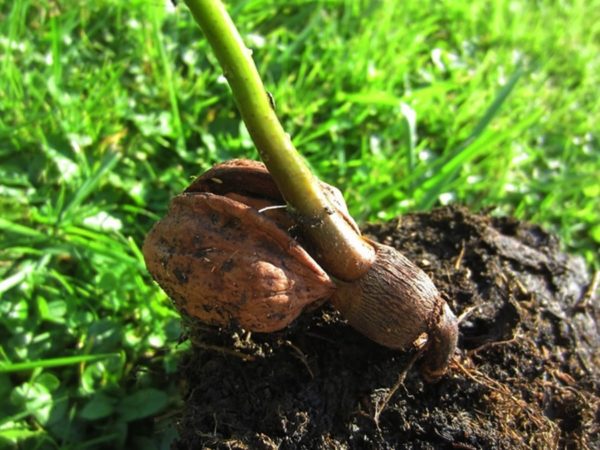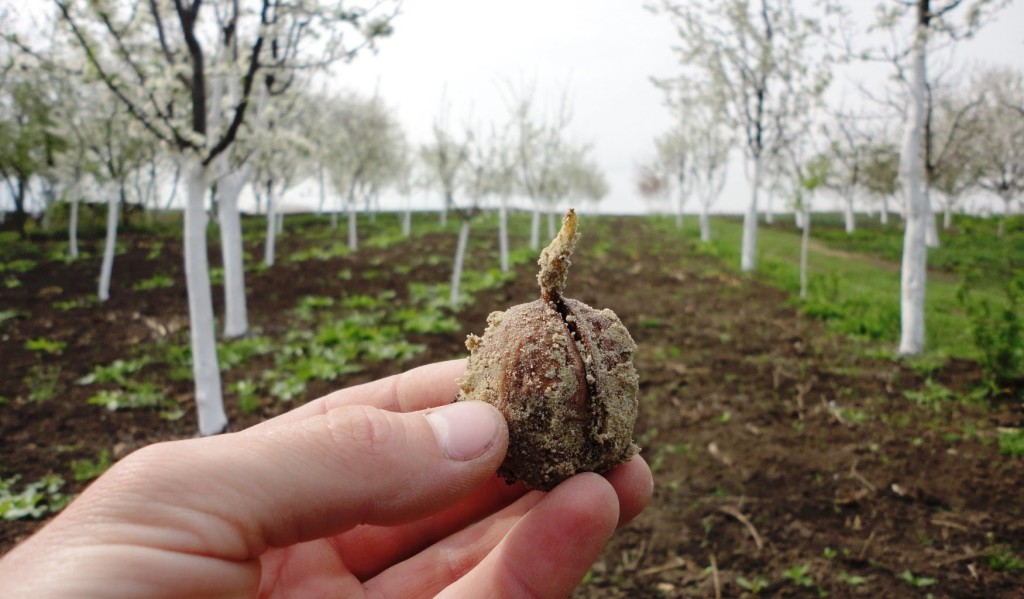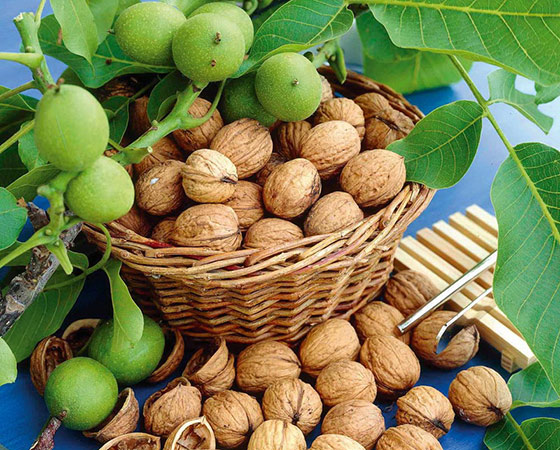Walnut tree is a long-liver, which for several centuries has been able to supply people with fruits filled with vitamins and nutrients. At first glance, the idea of planting a walnut tree near the house will seem strange, but this is quite feasible with proper planting and care of the nut.
Content
Features of Walnut Planting
Walnut seedlings are planted until the ground freezes in the fall, and in the spring after complete thawing. In order to have full fruiting, at least 2 trees are planted at home at a distance of 5 m from each other for pollination. When grown on an industrial scale, the distance between the nuts is about 10 m. Wind is involved in the pollination of trees. Loosening is carried out up to 2 times a season and 1 time in the winter. Walnut prefers mulch rather than interference in the near-root space.
Walnut planting time
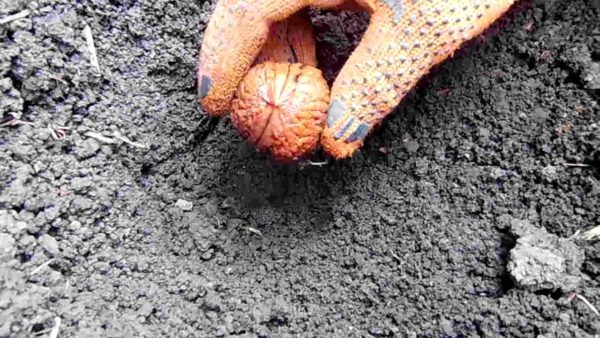 The timing of walnut planting most depends on the weather conditions of the place of future growth. In the Moscow region and surrounding areas, walnuts are planted in spring, immediately after the snow melts before the sap flow begins. Closer to the south and Ukraine, this procedure is also carried out in the autumn period. Best survival during leaf fall.
The timing of walnut planting most depends on the weather conditions of the place of future growth. In the Moscow region and surrounding areas, walnuts are planted in spring, immediately after the snow melts before the sap flow begins. Closer to the south and Ukraine, this procedure is also carried out in the autumn period. Best survival during leaf fall.
How to plant a young walnut tree in autumn
In order to plant a walnut in the fall and grow a fruiting tree, some conditions are observed. It is necessary:
- competently choose a seedling;
- not make a mistake with the landing time;
- choose the right place for landing;
- to land in an improved way.
Seedling Selection
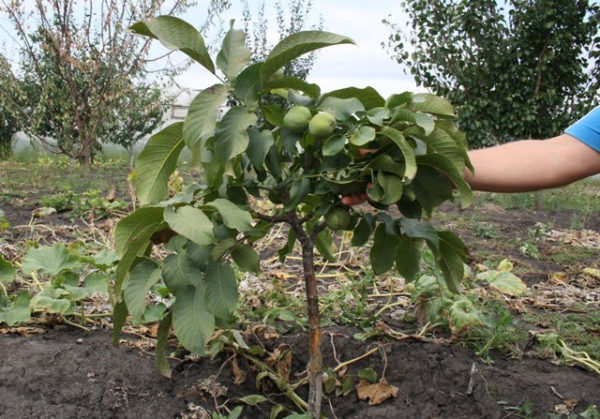 Walnut seedlings are bought in nurseries. Healthy and strong trees with a closed root system, without external signs of disease and flaws, are selected, weak and elongated are rejected. It is preferable to purchase 2-year-old seedlings, although their price is higher compared to annuals. If the roots are open, they are carefully examined. A quality seedling:
Walnut seedlings are bought in nurseries. Healthy and strong trees with a closed root system, without external signs of disease and flaws, are selected, weak and elongated are rejected. It is preferable to purchase 2-year-old seedlings, although their price is higher compared to annuals. If the roots are open, they are carefully examined. A quality seedling:
- there is one trunk, not 2;
- the place of vaccination has grown;
- the roots are not twisted;
- the trunk is lignified;
- height not more than 80 cm;
- barrel diameter of at least 90 mm.
Immediately before planting, a small crop of the seedling root is produced.
Seat selection
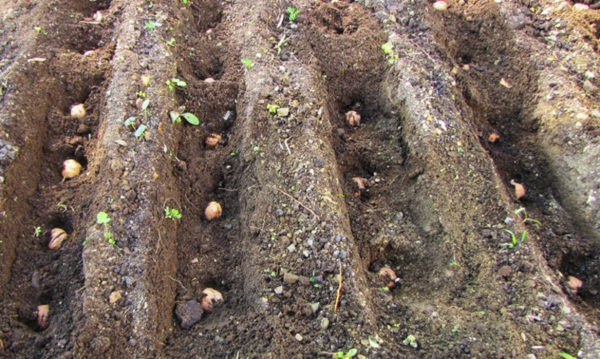 Walnut is a mountain resident with a beautiful lush crown. It prefers loams with low humidity and chernozems. He does not like marshy dense soil with groundwater coming close to the surface of the earth. He likes spaciousness and plenty of sunshine.
Walnut is a mountain resident with a beautiful lush crown. It prefers loams with low humidity and chernozems. He does not like marshy dense soil with groundwater coming close to the surface of the earth. He likes spaciousness and plenty of sunshine.
In the garden, the tree needs a bright place, taking into account the further growth and increase in the volume of the crown to 5 m in diameter. Therefore, walnuts are not planted near buildings (its strong roots are able to destroy the foundation), other fruit trees and beds with vegetables (takes all the food from the soil for itself and forms a shadow).Shrubs (currants, rose hips), bird cherry, raspberries, and viburnum are adjacent to the nut.
Landing pit
In autumn, a walnut pit 1 × 1 × 1 m in size is excavated for planting a walnut in the fall 14 days before the main work. The upper fertile layer is tilted to one side, and the sides for the pit are made from the lower one. In the earth from the upper layer add:
- a bucket of compost or humus;
- 200 g of ash.
The ingredients are thoroughly mixed.
Planting a seedling
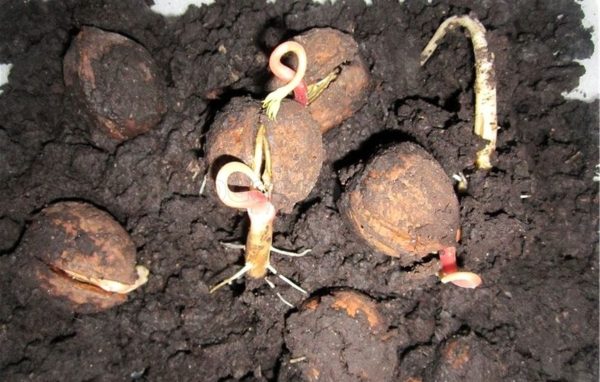 The most productive is landing according to the method of Nikolay Kiktenko.
The most productive is landing according to the method of Nikolay Kiktenko.
At the bottom of the pit lay:
- Broken bricks, small stones or pottery shards.
- About 1 kg of ammophos is poured with a bunch. Ammophos contains 52% phosphorus and 12% nitrogen in its composition. Carbonate soils are rich in calcium, nitrogen, potassium, but poor in phosphorus. Calcium, when phosphorus enters the soil, instantly binds it into insoluble forms. To prevent this from happening, reduce the area of contact of the fertilizer with the surface of the earth.
- Pour about 20 cm of the prepared mixture on top, put a seedling, straighten its roots.
- Fill the rest of the ground so that the vaccination site is not filled up.
- Gently scrolling the seedling around its axis, so that the earth more tightly grasped the roots.
- Tamping the earth so that air bubbles come out of it, and there are no voids.
- The mulch is laid on top in the form of straw manure (about 25 kg), which will prevent the roots from drying out in the summer and warm them in the winter.
- 6 buckets of water are poured under the seedling.
- Eight is tied to a young tree to a peg, which is driven from the side where the wind usually blows.
Walnut Care
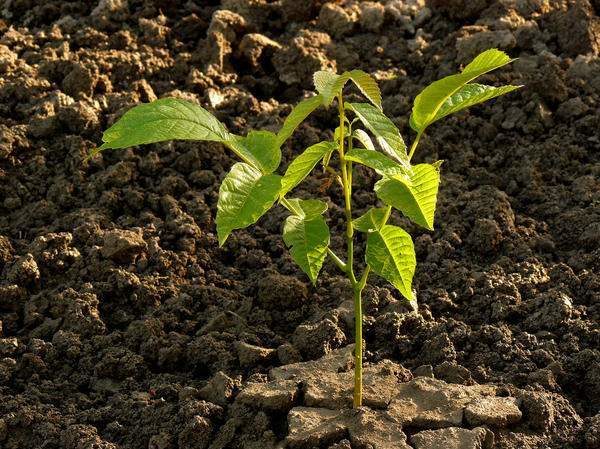 Although this tree is considered one of the most picky plants, it also requires some care. Without care, the owner risks growing a small long-lived tree, and a crooked-sided freak. Walnut care includes:
Although this tree is considered one of the most picky plants, it also requires some care. Without care, the owner risks growing a small long-lived tree, and a crooked-sided freak. Walnut care includes:
- top dressing;
- watering;
- preventive treatments against diseases and pests;
- pruning.
Watering
In hot summers, a young plant requires watering. 25-30 liters of nutritious moisture are poured under the tree at one time and watering is carried out 10 to 14 times during the summer. An adult nut is watered less often (2-3 times a month), but watering is increased to 60-80 liters of water under one tree. Trees more than 4 m in height practically do not need watering, with the help of powerful roots the nut extracts moisture from the depths of the earth.
Top dressing
If the planting pit was well seasoned with nutrients, the nut does not need additional fertilizer for 8-10 years.
After this period, nitrogen-containing fertilizers are applied under the tree in spring, phosphorus and potassium in the autumn at the rate of 10 g per 1 sq.m. Like organic nuts: compost, humus, ash. It can be poured into the trunk circle of 5-6 kg each year.
Winter preparations
Before winter, trunks of young seedlings are wrapped in white corrugated paper or covering material, which is removed in spring. Older trees are whitened to save the bark from cracking during frosts. Under each winter seedling, 6-8 buckets of water are poured.
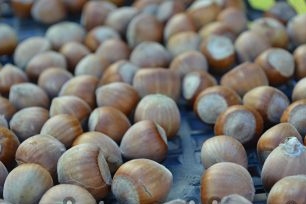 You may be interested in:
You may be interested in:Trimming and Shaping
At a young age, it is necessary to form a crown in the seedling in order to obtain the most fruit-bearing tree in the future. In the first year of a nut's life, one shoot is chosen mainly, the rest are slightly nipped. Subsequently, when 5-6 skeletal branches are formed, the lower branches are removed.When the gardener gives the crown the desired shape, further pruning will consist of removing damaged and broken branches.
Preventative treatments
It is always easier to take preventative measures than to cure a disease. A solution of copper sulfate is sprayed onto the plant in early spring, before the leaves bloom and in the fall, after leaf fall.
Diseases and the fight against them
Walnut is resistant to diseases and pests, but without leaving exposed to a number of diseases. These include:
- bacteriosis;
- brown spotting;
- root cancer;
- bacterial burn.
The characteristic signs of diseases and methods of combating them are clearly shown in the table:
|
Disease |
Reasons for occurrence |
Symptoms of the disease |
Fungicides, concentration, number of treatments |
Further actions |
|
Bacteriosis |
Heavy rains Excess Nitrogen Fertilizer |
Black spots on the surface of the leaves, their death Falling unripe nuts |
Copper sulfate, 1% solution, 2 treatments in spring and autumn |
Destruction of fallen leaves in autumn |
|
Brown spotting |
Frequent watering Heavy rains |
Brown spots spreading over the whole leaf, falling unripe fruits |
Strobes (4 g per 10 l of water), Vectra (2 g per 10 l of water) |
|
|
Root cancer |
The penetration of pathogens through damage in the trunk |
Convex growths appear on the cortex Ceases to bear fruit and dries up |
The growths are opened, washed with 1% r-rum caustic |
Rinsing the wound with water under pressure |
|
Bacterial burn |
Heavy rains |
Reddish spots appear on leaves, shoots, buds, spreading throughout the plant |
Copper sulfate, 1% solution, 2 treatments in spring and autumn |
Removing infected tree sections |
Walnut pests
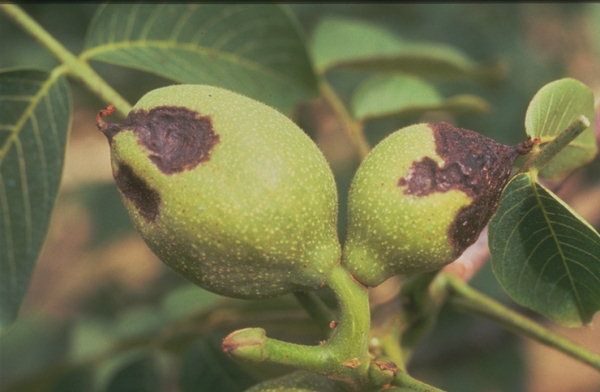 In addition to diseases, insects threaten the walnut tree. Among them:
In addition to diseases, insects threaten the walnut tree. Among them:
- The American butterfly is a malicious pest that annoys all fruit trees. For one vegetative period, to manage to produce 2-3 generations that destroy plants from July to October. They fight it with the help of microbiological preparations: Lepidocide or Dendrobacillin. On a tree, you need to spend 2 to 4 liters of the prepared solution. It can not be used during flowering of a nut.
- A warty nut mite destroys leaf blades without touching the fruit. Brown blisters appear on the leaves. Destroy drugs: Akarin, Aktara.
- Moth eats the fruits of walnut. The insect creeps into the nut and gnaws the core. During the season, 2 generations of the moth grow, which harms the tree from June to August. It is recommended to hang traps on the trees with smells that attract males. Remove and destroy fallen fruits and nests on the tree.
- Walnut moth larvae on the leaves. Hatching caterpillars gnaw through the insides of the leaves without touching the skin. They fight with Lepidocide, Decis, Decamethrin.
- Aphids can attack any tree or bush. It is a carrier of diseases. They fight against aphids with the help of Antitlin, Actellik or Biotlin.
There are a lot of pests, and in order not to miss their invasions, you should inspect the tree as often as possible.
Growing walnut from walnut
Having good seed, experienced nut growers themselves grow walnuts from walnuts. Seed Requirements:
- high-quality appearance without damage;
- medium hard shell;
- the nut should be large.
Seed preparation
There are 2 opinions on how to plant a nut:
- in shell;
- in purified form.
3-4 months before planting, the seeds in the soil are placed in containers of wet sand and kept cool. The bottom shelf of the refrigerator will do. This speeds up the process of cracking nuts and increases, in the future, future crops.
Before planting, the nuts are dipped in water, checking for germination. Both of them are considered suitable for planting, but drowned people are more likely to germinate.
Planting seeds
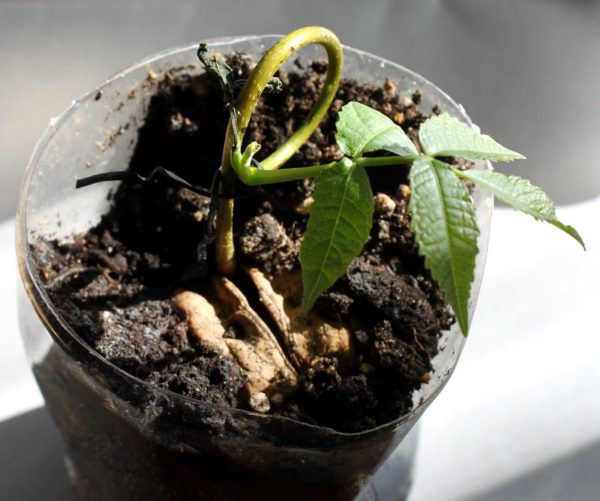 The nut fruit is planted to a depth of 4-5 cm in a pot with fertile soil.Further care over the next 2 years consists of watering, loosening and removing weeds.
The nut fruit is planted to a depth of 4-5 cm in a pot with fertile soil.Further care over the next 2 years consists of watering, loosening and removing weeds.
Features landing in different regions
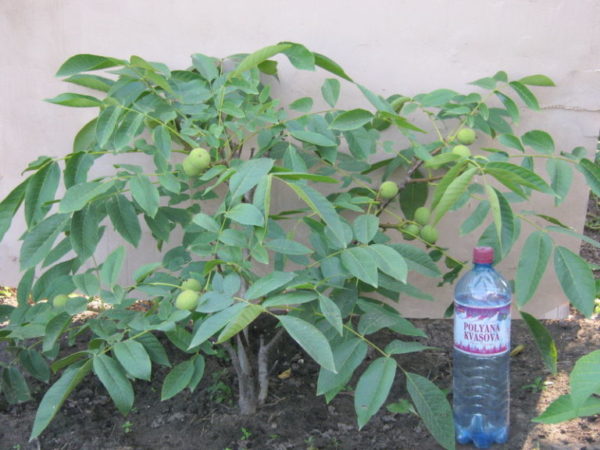 To plant a nut in different regions, you need to choose the right time. In the south, both spring and fall months are suitable. For the middle strip and northern latitudes - only spring.
To plant a nut in different regions, you need to choose the right time. In the south, both spring and fall months are suitable. For the middle strip and northern latitudes - only spring.
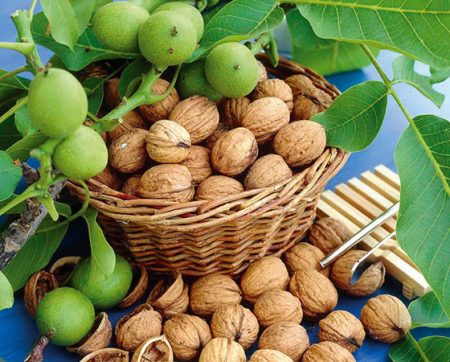 You may be interested in:
You may be interested in:Planting methods also vary. If in the south the nut is planted directly in the ground in spring, then in northern conditions, thus, it will not work to grow a fruiting tree. In the central non-Chernozem region, sometimes they get a positive result when planting seeds to a depth of 20-30 cm.
Harvest time
A signal to harvest will be a cracked green peel on the surface of the fruit. After harvesting, the fruits are placed in the basement. A week later, remove the green peel, wash and send them to dry. After all the procedures, the fruits are laid in storage.
Growing a nut on its site is a fascinating process, but it requires attention and diligence. But the tree that has grown for many years will thank the owner for the care and care of an excellent harvest.

